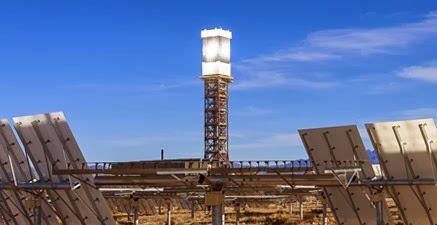Solar plant powers up, turns on desert show
 |
| BrightSource Tower surrounded by mirrors near Ivanpah Dry Lake. |
Orange County Register
Without fanfare, one of the biggest and most controversial solar developments in California has gone online in northeast San Bernardino County, creating a visual spectacle for travelers heading across the Nevada border on Interstate 15.
Meret Uteregges stood at the edge of the Ivanpah Valley early Wednesday afternoon and marveled at the sight below her.
Three arrays of thousands of mirrors blanket more than 5 square miles of the Mojave Desert landscape and focus sunshine on the tops of three towers, each taller than the length of a football field.
The mirror fields and the tower tops, glowing with an intensely bright white light, are proving to be a traffic stopper that dominates the landscape for miles.
“It is like science fiction,” said Uteregges, from Zurich, who stopped on the shoulder of Nipton Road, a few miles south of the solar field, to get a good look. “It is fascinating. I saw it being built a few years ago but didn't know it would be so big.”
The Ivanpah solar energy project was developed by BrightSource Energy Co. – which owns the plants, along with NRG Energy and Google – and now is operated by NRG Solar. It has been operating since the beginning of the year, according to officials with the California Energy Commission.
NRG spokesman Jeff Holland declined to provide details of the startup, saying only that the company in mid-February would publicize its electricity-production debut.
Monthly status reports available on the state Energy Commission's website said that one of the towers went into commercial operation Dec. 30. And a commission spokesman said the other two towers also have been producing power since that date.
The $2.1 billion project is expected to provide enough carbon-free electricity for 140,000 homes through contracts with Southern California Edison and Pacific Gas and Electric. It was supported with some $1.6 billion in federal loan guarantees and has been hailed by President Barack Obama.
Despite the benefits of clean energy, the project drew protests from some environmental and Native American groups. Native Americans said the project disturbed sacred ground in the Ivanpah Valley.
Environmentalists objected because the development consumed 5.6 square miles of desert tortoise habitat, displacing dozens of the reptiles, which have been relocated or are confined to holding pens. Tortoises are listed as a species threatened with extinction.
BrightSource's environmental reviews predicted that about 17 of the reptiles would be displaced. But after construction started in fall 2010, about 125 were captured on the site.
To make up for the lost habitat, BrightSource funded California's acquisition of about 7,200 acres elsewhere in the Mojave Desert.
When operators started testing the towers last year, a new concern emerged: Birds that flew into the heat zones around the towers died from burns. Federal fish and wildlife officials are tracking the bird deaths and taking possession of the carcasses, according to monthly status reports filed with the Energy Commission.
Some passers-by said it makes sense to take advantage of the desert's abundant sunlight.
Mark Tworek of Calgary, Alberta, said he saw the bright solar towers as he crested a hill in Nevada while riding his motorcycle on Nipton Road, southeast of the project.
“It is pretty amazing to see it in operation,” he said, sipping a soda at the Nipton Trading Post.
“With all the sunshine around here, it is a no-brainer.”
